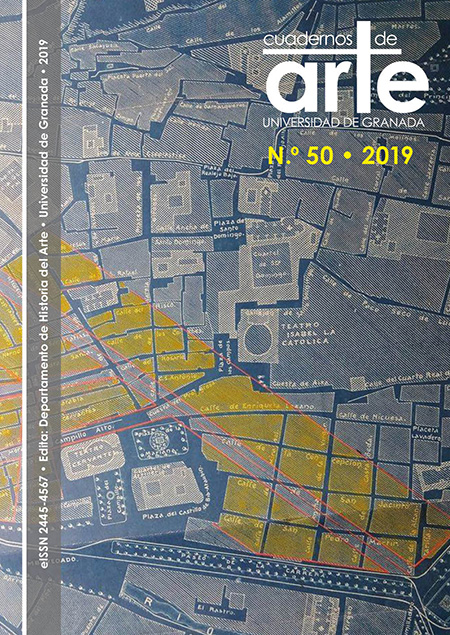The painting of the manuscript in Don Quixote: reflections from the History of Art
DOI:
https://doi.org/10.30827/caug.v50i0.11262Keywords:
painting, manuscript, joke, Quixote, art in Al-Andalus, Cervantes Saavedra, Miguel de, Cide Hamete BenengeliAbstract
The present paper proposes that Cervantes was probably aware of the historical rigor that it entailed to incorporate a figurative representation in the manuscript written by the Arabic historian, Cide Hamete Benengeli, and it aims to demonstrate that the interpretation of this episode as a mere joke by Cervantes is based on a mistaken premise. In order to do this, we analyze in detail the episode in chapter IX of the First Part of Don Quixote, and we reflect on the influence that the art in Al-Andalus could have had in the configuration of this episode, taking under consideration various notable cases of Islamic art that include figurative representations. Finally, we consider the relationship between Cervantes and the Islamic framework, focusing on his connections with the Muslim context and how his biography is reflected in the novel.
Downloads
References
Belting, H. (2012). Florencia y Bagdad: una historia de la mirada entre Oriente y Occidente. Madrid: Akal.
Boyano Guerra, I. (2008). Al-Ḥaŷarī y su traducción del pergamino de la Torre Turpiana. En: Barrios Aguilera, M. y García-Arenal, M. (Eds.). ¿La historia inventada? Los libros plúmbeos y el legado sacromontano (pp. 137-157). Granada: Fundación El Legado Andalusí.
Cervantes, M. y Clemencín, D. (Ed.). (1833). Don Quijote de la Mancha. Madrid: Oficina de D. E. Aguadó. Disponible en: http://bdh.bne.es/bnesearch/detalle/bdh0000199210 [Consultado el 1-12-2018].
Cervantes, M. y Rico, F. (Ed.). (1998). Don Quijote de la Mancha. Barcelona: Crítica.
Cervantes, M. (2003). El coloquio de los perros. Santa Fe (Argentina): El Cid Editor.
De Armas, F. (2006). Quixotic Frescoes: Cervantes and Italian Renaissance Art. Buffalo: Toronto University Press.
El-Outmani, I. (2005). El morisco Cide Hamete Bejarano, autor del Quijote. Espéculo: revista de Estudios Literarios, 30.
Gómez-Moreno, M. (1970). Pintura de moros en el Partal (Alhambra). Cuadernos de la Alhambra, VI, 155-164.
Graf, E. (2004). The Pomegranate of Don Quixote 1.9. En: De Armas, F. (Ed.). Writing for the eyes in the Spanish Golden Age (pp. 42-62). Lewisburg: Bucknell University Press.
Graf. E. (2007). Cervantes and modernity: four essays on Don Quijote. Lewisburg: Bucknell University Press.
López-Baralt, L. (1999-2002). El cálamo supremo (al-qalam al-aclā) de Cide Hamete Benengeli. Sharq Al-Ándalus, 16-17, 175-186.
Lucía Megías, J. M. (2016). La madurez de Miguel de Cervantes: una vida en la Corte (1580-1604). Madrid: EDAF.
Luque Moreno, J. (2013). Granada en el siglo XVI: testimonios de la época. Granada: editorial Universidad de Granada.
Marçais, G. (1932). La question des images dans l’art musulman. Byzantion, VII (1), 161-183.
Medina, A. (2005). Cervantes y el islam. El Quijote a cielo abierto. Barcelona: Carena.
Puerta Vilchez, J. M. (1997). Historia del pensamiento estético árabe: Al-Ándalus y la estética árabe clásica. Madrid: Akal.
Puerta Vílchez, J. M. (2016). Celebración de la imagen y estética caligráfica en el islam árabe clásico. En: Roldán Castro, F. (Ed.). La imagen y la palabra en el islam (pp. 13-52). Sevilla: Editorial universitaria de Sevilla.
Sánchez Vázquez, A. (2007). De la estética de la recepción a una estética de la participación. México D. F.: Facultad de Filosofía y Letras UNAM.
Spitzer, L. (1955). Perspectivismo lingüístico en El Quijote. En: Spitzer, L. Lingüística e historia literaria (pp. 161-225). Madrid: Gredos.
Yarza Luances, J. (2005). Vestiduras ricas: el Monasterio de las Huelgas y su época 1170-1340: del 16 de marzo al 19 de junio de 2005 en el Palacio Real de Madrid. Madrid: Patrimonio Nacional.
Downloads
Published
How to Cite
Issue
Section
License
Los autores que publican en esta revista están de acuerdo con los siguientes términos:- Los autores conservan los derechos de autor y garantizan a la revista el derecho de ser la primera publicación del trabajo al igual que ser licenciado bajo una licencia Creative Commons que permite a otros compartir el trabajo con un reconocimiento de la autoría del trabajo y la cita de la fuente original, con un uso no comercial y siempre que no se hagan obras derivadas.
- Los autores pueden establecer por separado acuerdos adicionales para la distribución no exclusiva de la versión de la obra publicada en la revista (por ejemplo, situarlo en un repositorio institucional o publicarlo en un libro), con un reconocimiento de su publicación inicial en esta revista.
- Se permite y se anima a los autores a difundir sus trabajos electrónicamente (por ejemplo, en repositorios institucionales o en su propio sitio web) antes y durante el proceso de envío, ya que puede dar lugar a intercambios productivos, así como a una citación más temprana y mayor de los trabajos publicados (Véase The Effect of Open Access) (en inglés).






 ISSN-e: 2445-4567
ISSN-e: 2445-4567








